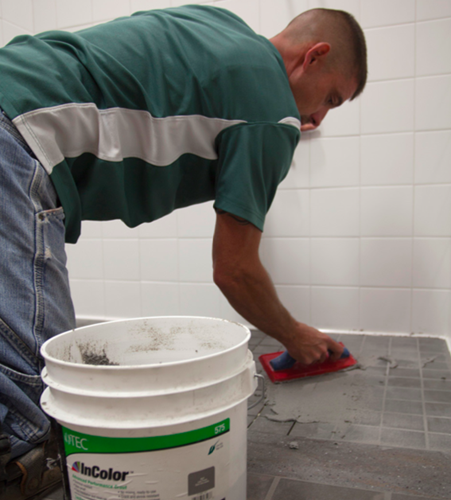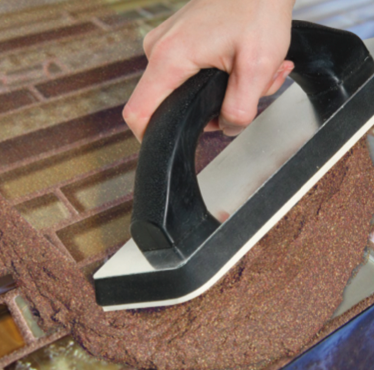Top 10 Myths About Mixing Grout

The grout that you choose to work with can make a big difference in your flooring installation. If you’re an experienced contractor, you’re already aware that not all grout is created (or mixed) equally.
But there are a few incorrect myths floating around when it comes to using grout, especially since new products are now available to meet industry demands around tile and flooring. Let’s break down the top ten myths around mixing grout.
Myth #1 - Temperature doesn’t make a difference.
The temperature of your powder and water plays a role in how quickly your mixture cures.
Hot powder and/or hot water will cure more quickly than a cold mixture. But, the higher the temperature of the water or the powder, the shorter the working time of your grout mixture. If you stay within the temperature range provided on the instructions, you can plan adequate time to complete the project.
Myth #2 - Just add water! Adding a bit more water will get more working time with your grout.
Excess water weakens your grout mixture.
If water is added to “stretch out” the working time of your grout, it changes the structure of the mixture. This eventually leads to cracking and color inconsistency.
Myth #3 - Get your high-speed drill handy. It will save on mixing time.
Using a higher speed might save you time, but it causes friction...and heat.
Mix with a low-speed (under 350 RPM) drill to avoid flash-setting your grout. Higher speeds will generate heat — and lead to less working time with the grout mixture.
Myth #4 - You can lift or lower the paddle during mixing, as needed.
Moving the mixing paddle up and down in your grout can trap air in the mixture. That means you’ll wind up with air bubbles which show up as pinholes in cured grout. You should try to avoid whipping any air into your mixture by keeping the drill steady.
Myth #5 - I’ve been doing this for decades; I can eyeball how much water I need.
Always read the instructions on your product packaging, especially if you’re trying a new material.
The new technology in grouting products available today might not react to water how you’d think. Some grout might look dry when you first start mixing, for example, but gradually loosen up over time. Adding too much water upfront can weaken the structure of your grout, leading to cracking and color issues.

Myth #6 - Use whatever water you have on hand.
“Water is water.” This is not true!
Water is an important element of your grout solution, and the water you combine with grout powder should be clean and potable. Dirty water or water with a high mineral content can cause grout discoloration.
Myth #7 - Use whatever grout you have on hand, it’s just dirt in a bag!
Grout is chemistry in a bag.
Leaving an open bag on the site or in your truck exposes this chemical mixture to humidity in the air. The cement component of grout will hydrate when there’s moisture around. If your grout powder has already started to hydrate before installation, it might not cure properly after you’ve mixed and placed it.
Myth #8 - Why would I worry about slaking grout? It’s a waste of time.
Letting your grout sit or slake after you’ve mixed it will allow for optimal performance of the grout. Remember, it’s a chemical reaction!
“After slaking, the grout will feel a bit stiffer, but don’t add more water. Remix the grout by hand again to loosen it up,” writes Harrison Kral for Construction Pro Tips. Always follow the manufacturer’s instructions for slaking, since it’s different for every product.
Myth #9 - Why would I worry about grout additives? They’re a waste of money.
Grout additives are sometimes required for commercial and exterior applications, since they enhance the grout’s performance in high traffic or freeze/thaw environments. There’s an additional cost upfront, but these additives can extend the life of the grout and help protect your client’s flooring or tile design.
Myth #10 - No need to read directions! All grouts mix up the same.
Here’s another myth easily busted. You should always look at your product packaging for instructions on mixing grout. There are ultimately three types of grout: cementitious, epoxy and pre-mixed.
Cementitious: This type of grout is mixed with water or additives, with a manufacturer-specified demand.
Epoxy: No water is added to epoxy grout, which typically includes resin, hardener and sand.
Pre-mixed grout: Ready to go from the pail for an easy and reliable installation.


Working with a grout mixture you can rely on will make any project go more smoothly. You can check out TEC Specialty’s array of high-performing grout products here. Or if you need professional tips for working with grout in your next project, take a look at our other grout articles.
